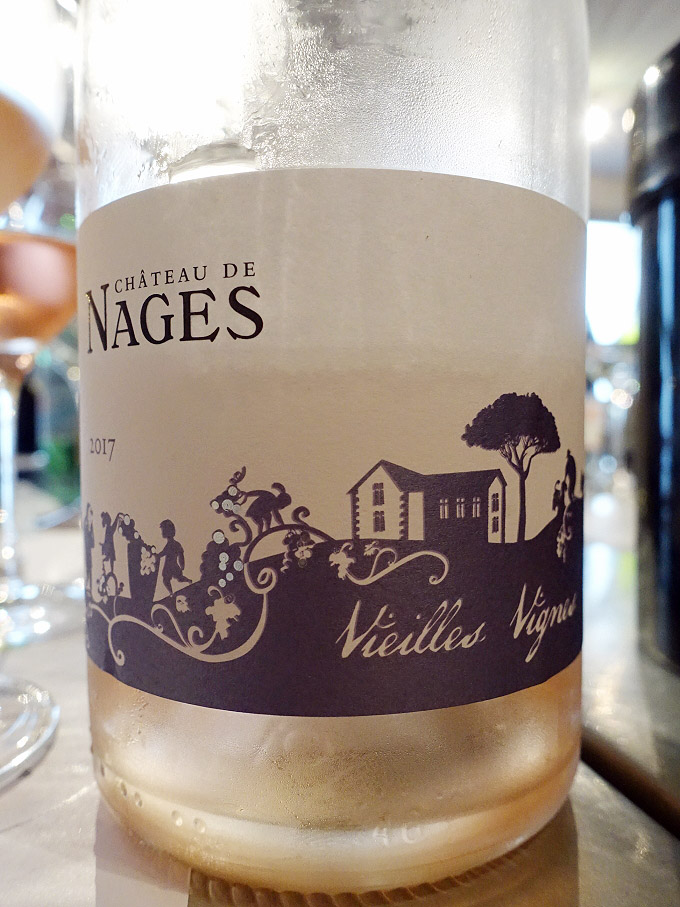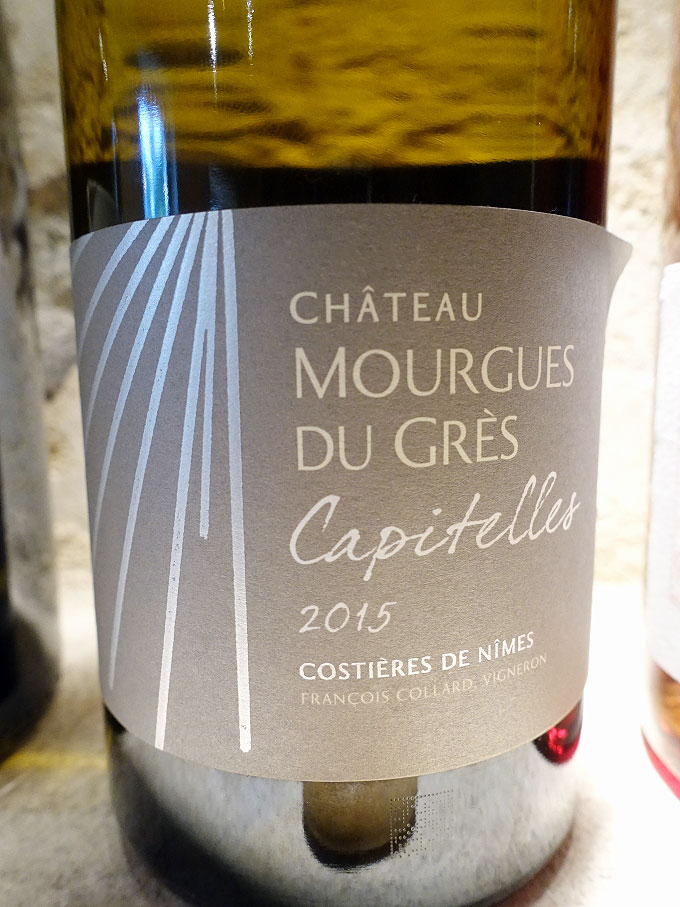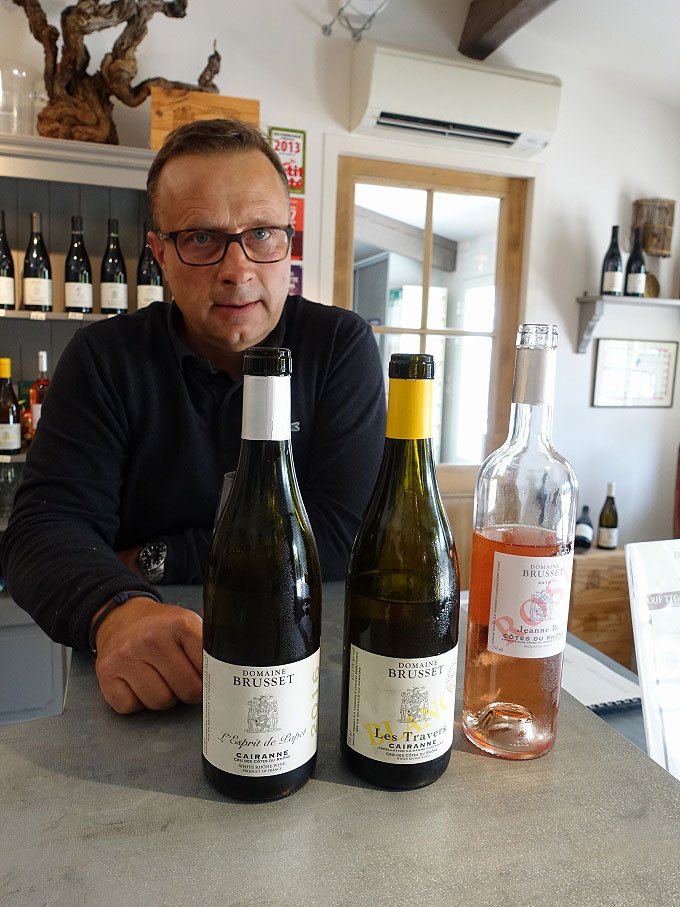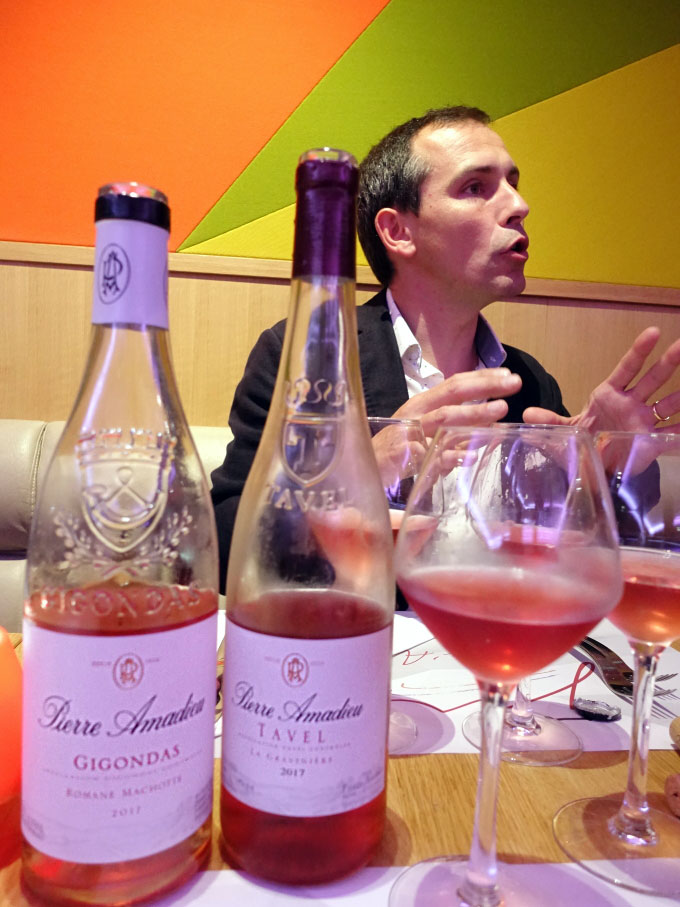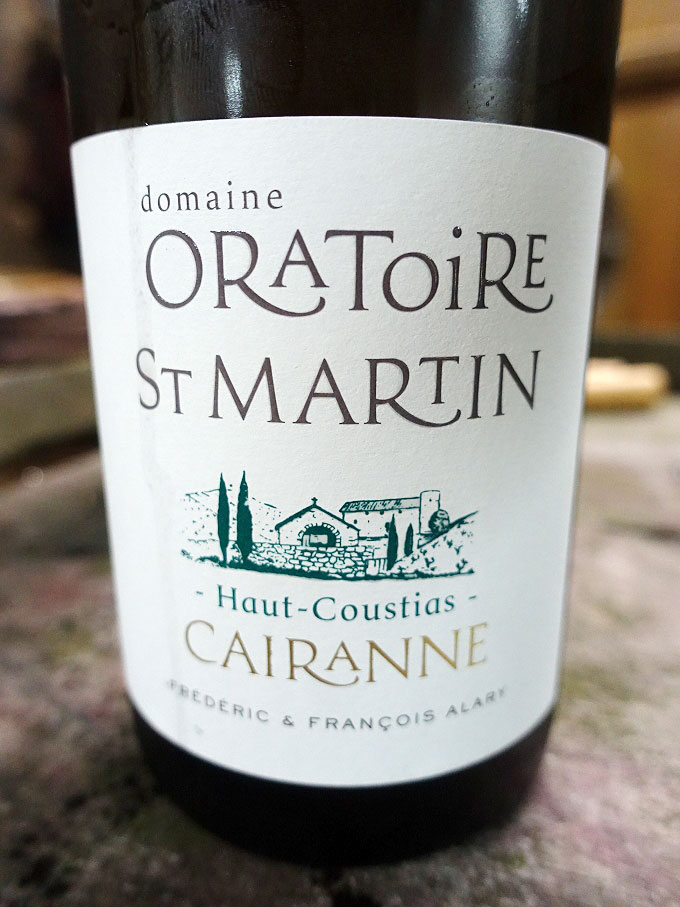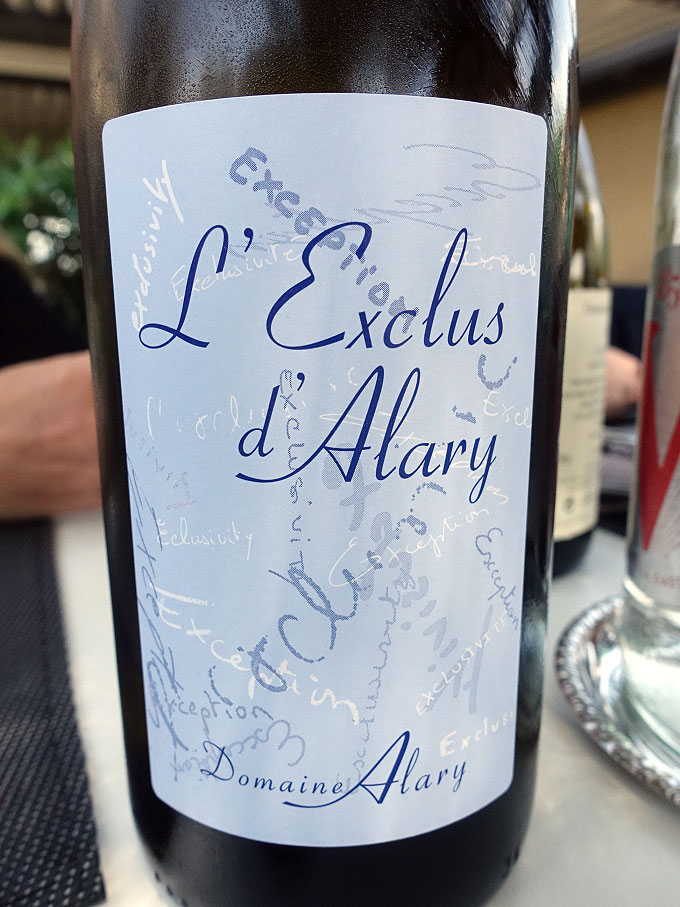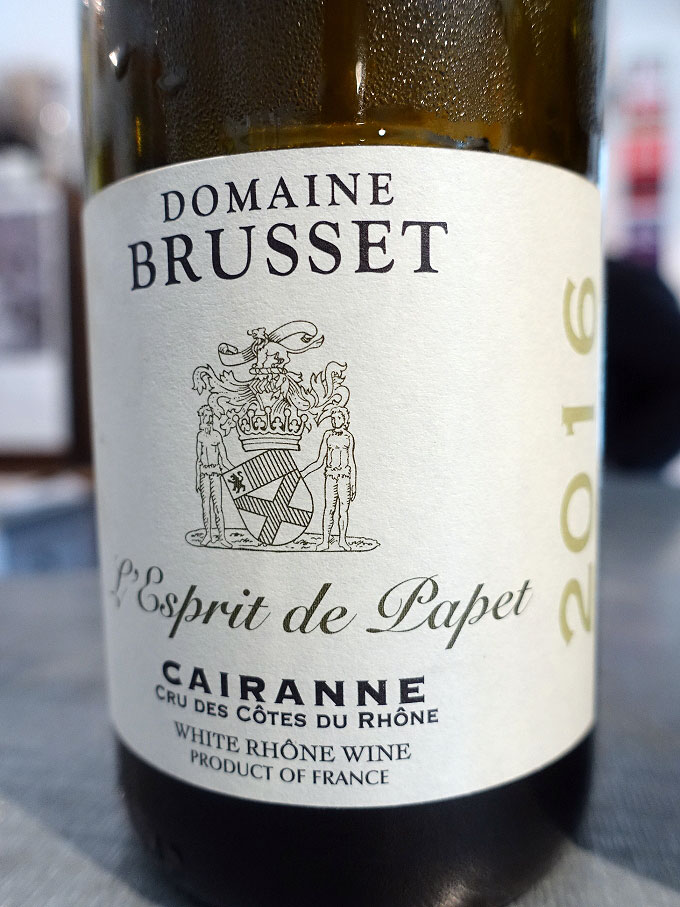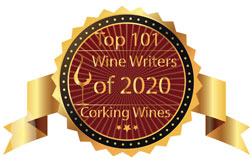After visits to Luberon and Ventoux, and Cairanne earlier in the week, our focused on the Costières de Nîmes appellation. This region is the southern-most wine-growing region of the Rhône Valley and exhibits a rich history and culture dating back to Greek and Roman times. In the year 280 A.D., the area was replanted with vines after the decree banning viticulture was revoked and is considered to be one of the first winegrowing regions in France. Winegrowing was further encouraged in the 17th century, and became even more important when the Canal du Midi was linked with the Rhône River in the 19th century.
The appellation was known as Costières du Gard when it was granted AOC status in 1986, and only had its name changed to Costières de Nîmes in 1989. In 2004, Costières de Nîmes was moved from Languedoc to the Rhône wine region because the wines were more reflective of the typical characteristics of Rhône than of the Languedoc. Today, Costières de Nîmes produces 8% of the wines from Rhône, of which 35% are rosé and 5% white wines. Like other Rhône AOCs, blending of at least two grape varieties is required. For rosé wines, Syrah is usually combined with either Grenache and/or Mourvedre, and sometimes Carignan and Cinsault. White wines are usually composed of Grenache Blanc, Roussanne, and Marsanne, and sometimes Viognier, Clairette, Bourboulenc, Macabeu, and Vermentino (Rolle).
 The day began with a visit to Château de Nages, where Tina Gassier, wife of renowned winemaker Michel Gassier, took us through some of their impressive current offerings of white and rosé wines from both Domaine Gassier and Château de Nages labels, and ranged in vintage from 2014 to 2017. They have vineyards in the northern part of the appellation featuring "galets" (i.e. pebbles) that sit atop iron-rich red clay, while some of this area is covered by a thin blanket of loess (wind-blown silt) that is very suitable for white varietals and Syrah. Their Bek Vineyard to the south, which was acquired fairly recently, has a base of chalk and “safres” layers that sit below a layer of red sandstone (iron-rich clay and sand) and is topped by “cailloutis” (pebbles from the ancient Durance River) on the higher elevations. The terroir of the Bek Vineyards changes as you move to lower elevations, with chalk and “safres” layers closer to the surface and topped with a layer of sandy-clay loam, offering freshness and salinity to the wines due to the vineyard being located at a fault line. At the lowest point of the Bek Vineyard, the alluvium soil that sits on top of the chalk and “safres” layer is rich in nutrients and limestone and offers minerality and freshness - white wine varietals are planted here. Unfortunately, due to the rainy weather, we were not able to see the vineyards, but I can imagine it would have been quite the sight.
The day began with a visit to Château de Nages, where Tina Gassier, wife of renowned winemaker Michel Gassier, took us through some of their impressive current offerings of white and rosé wines from both Domaine Gassier and Château de Nages labels, and ranged in vintage from 2014 to 2017. They have vineyards in the northern part of the appellation featuring "galets" (i.e. pebbles) that sit atop iron-rich red clay, while some of this area is covered by a thin blanket of loess (wind-blown silt) that is very suitable for white varietals and Syrah. Their Bek Vineyard to the south, which was acquired fairly recently, has a base of chalk and “safres” layers that sit below a layer of red sandstone (iron-rich clay and sand) and is topped by “cailloutis” (pebbles from the ancient Durance River) on the higher elevations. The terroir of the Bek Vineyards changes as you move to lower elevations, with chalk and “safres” layers closer to the surface and topped with a layer of sandy-clay loam, offering freshness and salinity to the wines due to the vineyard being located at a fault line. At the lowest point of the Bek Vineyard, the alluvium soil that sits on top of the chalk and “safres” layer is rich in nutrients and limestone and offers minerality and freshness - white wine varietals are planted here. Unfortunately, due to the rainy weather, we were not able to see the vineyards, but I can imagine it would have been quite the sight.
The vineyards at Château de Nages have been passed along 4 generations, and the story begins when Joseph Torres purchased the southern Rhône estate during World War II. After the passing of Mr. Torres, his son-in-law, Alfred Gassier, begins managing the property all the while residing in Algeria with his wife. He helps his sons re-construct their lives in France, with the eldest son, Jean Gassier taking the reins and restoring farm while the second son, Roger Gassier, restored the Château and the property. Michel is the great grandson of Joseph and was asked to take over the property in 1993 when his father retired.
Today, Château de Nages has 112 hectares of vineyards. 32% of their production is devoted to rosé wines, while is 16% to white wines, making them one of the larger producers of white wines in Costières de Nîmes. Vineyards are organically farmed, and there is a commitment to protecting the ecosystem and using resources wisely. All of the wines among the half dozen we tasted were delicious, and some were downright excellent. Fortunately for us, these wines do show up in our market from time to time. However, I think I will have to make another trip out to Château de Nages to take a stroll through the vineyards.
The second stop of the day was meeting Cyril Marès at Mas Carlot - Château Paul Blanc. Upon arriving at the winery, I thought to myself that the buildings looked rather historic. In fact, I learned that the buildings were from the 17th century, remodelled in the 19th century by the Grasset family, and fully restored by Paul Blanc a century later. Roman remains dating back to more than 2000 years old have also been found around the Mas. The visit began with a tour of the vineyards in Cyril's SUV - since it was raining on and off, and we would be able to see more of the 75 hectare property that was littered with round pebbles coloured by the red clay of the Costières, known locally as "Grès".
 After returning to the winery and getting a quick look at the tank and barrel rooms, we began tasting the wines with Cyril. Mas Carlot - Château Paul Blanc is actually the winery of Cyril's wife, Nathalie Blanc-Marès. She is an oenologist and the winemaker at Mas Carlot, and has been running the estate since 1998, following in the footsteps of her father, Paul Blanc. We didn't actually get to meet Nathalie, but Cyril tells us that she prefers to craft her wines in an elegant and fresh style, allowing the wines to express the Domaine's terroir fully. We tasted through the portfolio of whites and rosé wines (5 wines in all) and each wine was delicious and of very good quality. In 2018, Cyril Marès took over complete management of the estate and is currently moving towards organic farming.
After returning to the winery and getting a quick look at the tank and barrel rooms, we began tasting the wines with Cyril. Mas Carlot - Château Paul Blanc is actually the winery of Cyril's wife, Nathalie Blanc-Marès. She is an oenologist and the winemaker at Mas Carlot, and has been running the estate since 1998, following in the footsteps of her father, Paul Blanc. We didn't actually get to meet Nathalie, but Cyril tells us that she prefers to craft her wines in an elegant and fresh style, allowing the wines to express the Domaine's terroir fully. We tasted through the portfolio of whites and rosé wines (5 wines in all) and each wine was delicious and of very good quality. In 2018, Cyril Marès took over complete management of the estate and is currently moving towards organic farming.
The Marès family has a long tradition of winemaking going back centuries. Cyril was born in Nîmes and has always lived between the vineyards and orchards of his father Roger Marès. Mas des Bressades neighbours Mas Carlot and was founded by Roger in 1964. After studying agronomy, viticulture and oenology in Montpellier, Cyril went on to vinify on other continents before returning to Mas des Bressades and taking over the reins in 1996 and becoming the latest of 6 generations to make wine. At Mas des Bressades, Cyril and his small team try with passion to produce ripe and fruity wines. Today, the estate is managed by Cyril's cousin, Alix Marès. The fabulous estate terroir is comprised of Siliceous pebbles which originated from the Rhône River Basin dating back to the Quaternary era and is 6 to 15 metres thick. Roussanne is the most widely planted white varietal on the property, leading to Roussanne-dominate white wines, while the single rosé is a Grenache-led blend. After tasting the yummy wines of Mas des Bressades with Cyril at Mas Carlot, we headed out for lunch.
Hotel Restaurant Le Cours was the venue for lunch, a family hotel in Saint-Gilles that offers cultural fare in the tradition of the Camargue. It was a short drive away from Mas Carlot and Cyril joined us. I expected lunch to be on the quiet side, however, it got really interesting after Cyril pulled out 10 whites and rosés for tasting. All of the wines were from various producers in Costières de Nîmes and Cyril did his best to provide some information regarding each of the wines, along with tech sheets that came in handy. A couple of wines, one each from Domaine du Vistre and Château d'Or et de Gueules really stood out for me, and wine reviews of each are provided below.
As for lunch, the shrimp I ordered was loaded with garlic and really delicious, but made it a bit difficult for tasting the wines and, of course, it was a little messy. Nevertheless, I enjoyed it and would highly recommend this entrée.
We visited the family-owned and -operated Château Mourgues du Grès for the only winery stop of the afternoon - and it was quite the visit! The site is located in Beaucaire on a slope in Costières de Nîmes and is a former 16th century agricultural estate of the Ursulines de Beaucaire. It takes its name from the nuns called "Mourgues" in the Provençal language, and the "Grès" which are the rounded stones found across Costières de Nîmes and give character to the wines from this region. The "grès" were transported here naturally via the River Rhône during the Ice Age. Since the weather had cleared up around here and the ground was fairly dry, owner and vigneron François Collard and his wife Anne gave us a tour of the property, which involved driving up the hill.
The first stop along the way was an ancient Roman archaeological site that was recently discovered while planting a new vineyard. We then drove up to a plateau that featured vineyards with plenty of "grès" on the ground and were also told about Mistral (winds) that plays an important role in winegrowing. The mistral from the north is dry, while the south wind brings moisture from the sea. Together, these winds accentuate the diurnal temperature and brings freshness to the wines. We went further up the hill and got a lovely view of the vineyards below, the town of Beaucaire, and the eastern plateau facing the River Rhône. After the brief tour of the property, we headed back to the tasting room to learn more and taste their portfolio of white and rosé wines.
Of their entire production, 20% is devoted to white wines, which is fairly high among Rhône producers. Château Mourgues du Grès is a certified organic winery, being mindful and respectful of nature and the environment. Since 2015, they have not used sulphur during winemaking (a slight addition of sulphur is added at bottling to ensure stability of the wine). All six wines we tasted were delicious - 3 whites and 3 rosés - ranging in style from fresh and fruity to something more serious for gastronomie. Most of the wines also had a fine mineral element. All in all, I was very satisfied with my visit to Château Mourgues du Grès.
This concludes a fascinating day in Costières de Nîmes, an area rich in winemaking history that goes back more than two-thousand years. The fresh white wines showed fine mineral character thanks to the terroir, while the rosés wines were deliciously fresh and fruity. From here, we moved to Lirac and Tavel the following day as we toured through the southern Rhône Valley.
MICHEL GASSIER LOU COUCARDIÉ BLANC 2014 - AP Costières de Nîmes, Rhône, France (XD) - $35
Bek vineyard. Blend of 50% Roussanne, 30% Grenache Blanc, and 20% Viognier grown on galets and sandy limestone soils over beds of safres and chalk. Barrel-fermented and aged on the lees for 9 months. Medium+ intensity nose of lanolin, yellow floral, anise, and herbs. The palate is medium-to-full bodied with a nice mouthfeel and lovely aroma replays that are balanced with fresh acids. Chalky mineral notes appear mid-palate and continue through to the long finish. Score: 90+ pts
Agent: Halpern Enterprises (ON), Le Maitre de Chai (QC)
CHÂTEAU DE NAGES VIEILLES VIGNES ROSÉ 2017 - AP Costières de Nîmes, Rhône, France (#496919) (XD) - $20
A blend of 80% Grenache and 20% Mourvèdre, the nose is subtle but offers rich cherry and strawberry aromas, while the medium-full bodied palate has nice aroma replays supported by balanced, juicy acids. There's some structure to this dry rosé that has a nice, rich texture. Finish length is very good. A serious, gastronomie rosé. Score: 90 pts
Agent: Profile Wine Group (ON), LCC Vins et Spiritueux (QC)
MAS CARLOT LA TERRE NATALE 2016 - AP Clairette de Bellegarde, Rhône, France (XD) - 10 €
Neighbouring Costières de Nîmes, this Clairette de Bellegarde appellation wine is 100% Clairette and mostly raised in concrete tanks (20% in oak). This elegant white wine has a medium+ intensity nose that is herbally with lemon oil, citrus, and stone fruits. It is medium+ bodied on the palate with fine minerally and balanced aroma replays and some fennel notes. Nicely textured with succulent acids and long finishing. Score: 90 pts
Agent: Nicholas Pearce Wines (ON)
MAS DES BRESSADES CUVÉE EXCELLENCE BLANC 2017 - AP Costières de Nîmes, Rhône, France (XD) - 12 €
70/30 Roussanne and Viognier that was barrel-fermented and aged oak for 5 months. Medium-high, wood-inflected nose of baked pear, white peach, subtle vanilla, and floral aromas. It is medium-full bodied, rounded, and richly structured with oak nicely integrated on the palate. Nice aroma replays and somewhat chalky textured. Balanced acids. Shows impressive complexity and very good finish length. Score: 89 pts
Agent: Vinexx (ON)
DOMAINE DU VISTRE CUVÉE GLADIATEUR ROSÉ 2017 - AP Costières de Nîmes, Rhône, France (XD) - 8 €
Blend of 90% Grenache and 10% Syrah from hillside vineyards featuring sandstone and pebbles from the Rhône river, this has a medium-high intensity nose that is clean and fresh with currant, strawberry, mineral, and herbal aromas. Medium-bodied on the very clean palate with fresh acids and nicely balanced aroma replays and a long-lasting finish. Score: 88+ pts
Agent: N/A
CHÂTEAU D'OR ET DE GUEULES TRASSEGUM BLANC 2017 - AP Costières de Nîmes, Rhône, France (XD) - 14.50 €
Organic and biodynamic blend of 80% Roussanne (barrel-fermented), 10% Grenache Blanc, and 10% Rolle (Vermentino). Barrel ageing evident on the nose, along with clean fresh lemon and herbal scents. It's medium-full bodied, a touch creamy, and nicely textured on the palate with more barrel influenced and pear flavours. Balanced acids. There's some complexity on the long finish. Score: 88 pts
Agent: N/A
CHÂTEAU MOURGUES DU GRÈS FLEUR D'EGLANTINE 2017 - AP Costières de Nîmes, Rhône, France (XD) - 7.5 € 88 pts wine review
CHÂTEAU MOURGUES DU GRÈS GALETS ROSÉS 2017 - AP Costières de Nîmes, Rhône, France (XD) - 7.5 €
Blend of Syrah, Grenache, and 15% Mourvèdre made in the saignee method. Medium+ intensity and fruity with red berry, candied cherry and strawberry aromas. It is medium+ bodied, fresh, lively and dry with nice, fruity aroma replays and some structure. Minerally on the finish, with very good length. Score: 88 pts
CHÂTEAU MOURGUES DU GRÈS CAPITELLES BLANC 2015 - AP Costières de Nîmes, Rhone, France (XD) - 16 €
Blend of old vines Grenache Blanc that grow on chalky soils (rare for this appellation), Roussanne, and Viognier, and is barrel-fermented and aged. Pours deep yellow gold and offers a medium-high intensity and slightly mature nose that is waxy with baked apple, white and yellow flowers. It is medium-full bodied and fleshy on the palate with nice aroma replays. Acids are still quite fresh and juicy. Very good length on the limestone mineral finish. Should drink well for another 5 years. Score: 89 pts
Agent: Brand New Day Wines & Spirits (ON)
The appellation was known as Costières du Gard when it was granted AOC status in 1986, and only had its name changed to Costières de Nîmes in 1989. In 2004, Costières de Nîmes was moved from Languedoc to the Rhône wine region because the wines were more reflective of the typical characteristics of Rhône than of the Languedoc. Today, Costières de Nîmes produces 8% of the wines from Rhône, of which 35% are rosé and 5% white wines. Like other Rhône AOCs, blending of at least two grape varieties is required. For rosé wines, Syrah is usually combined with either Grenache and/or Mourvedre, and sometimes Carignan and Cinsault. White wines are usually composed of Grenache Blanc, Roussanne, and Marsanne, and sometimes Viognier, Clairette, Bourboulenc, Macabeu, and Vermentino (Rolle).
 The day began with a visit to Château de Nages, where Tina Gassier, wife of renowned winemaker Michel Gassier, took us through some of their impressive current offerings of white and rosé wines from both Domaine Gassier and Château de Nages labels, and ranged in vintage from 2014 to 2017. They have vineyards in the northern part of the appellation featuring "galets" (i.e. pebbles) that sit atop iron-rich red clay, while some of this area is covered by a thin blanket of loess (wind-blown silt) that is very suitable for white varietals and Syrah. Their Bek Vineyard to the south, which was acquired fairly recently, has a base of chalk and “safres” layers that sit below a layer of red sandstone (iron-rich clay and sand) and is topped by “cailloutis” (pebbles from the ancient Durance River) on the higher elevations. The terroir of the Bek Vineyards changes as you move to lower elevations, with chalk and “safres” layers closer to the surface and topped with a layer of sandy-clay loam, offering freshness and salinity to the wines due to the vineyard being located at a fault line. At the lowest point of the Bek Vineyard, the alluvium soil that sits on top of the chalk and “safres” layer is rich in nutrients and limestone and offers minerality and freshness - white wine varietals are planted here. Unfortunately, due to the rainy weather, we were not able to see the vineyards, but I can imagine it would have been quite the sight.
The day began with a visit to Château de Nages, where Tina Gassier, wife of renowned winemaker Michel Gassier, took us through some of their impressive current offerings of white and rosé wines from both Domaine Gassier and Château de Nages labels, and ranged in vintage from 2014 to 2017. They have vineyards in the northern part of the appellation featuring "galets" (i.e. pebbles) that sit atop iron-rich red clay, while some of this area is covered by a thin blanket of loess (wind-blown silt) that is very suitable for white varietals and Syrah. Their Bek Vineyard to the south, which was acquired fairly recently, has a base of chalk and “safres” layers that sit below a layer of red sandstone (iron-rich clay and sand) and is topped by “cailloutis” (pebbles from the ancient Durance River) on the higher elevations. The terroir of the Bek Vineyards changes as you move to lower elevations, with chalk and “safres” layers closer to the surface and topped with a layer of sandy-clay loam, offering freshness and salinity to the wines due to the vineyard being located at a fault line. At the lowest point of the Bek Vineyard, the alluvium soil that sits on top of the chalk and “safres” layer is rich in nutrients and limestone and offers minerality and freshness - white wine varietals are planted here. Unfortunately, due to the rainy weather, we were not able to see the vineyards, but I can imagine it would have been quite the sight.The vineyards at Château de Nages have been passed along 4 generations, and the story begins when Joseph Torres purchased the southern Rhône estate during World War II. After the passing of Mr. Torres, his son-in-law, Alfred Gassier, begins managing the property all the while residing in Algeria with his wife. He helps his sons re-construct their lives in France, with the eldest son, Jean Gassier taking the reins and restoring farm while the second son, Roger Gassier, restored the Château and the property. Michel is the great grandson of Joseph and was asked to take over the property in 1993 when his father retired.
Today, Château de Nages has 112 hectares of vineyards. 32% of their production is devoted to rosé wines, while is 16% to white wines, making them one of the larger producers of white wines in Costières de Nîmes. Vineyards are organically farmed, and there is a commitment to protecting the ecosystem and using resources wisely. All of the wines among the half dozen we tasted were delicious, and some were downright excellent. Fortunately for us, these wines do show up in our market from time to time. However, I think I will have to make another trip out to Château de Nages to take a stroll through the vineyards.
The second stop of the day was meeting Cyril Marès at Mas Carlot - Château Paul Blanc. Upon arriving at the winery, I thought to myself that the buildings looked rather historic. In fact, I learned that the buildings were from the 17th century, remodelled in the 19th century by the Grasset family, and fully restored by Paul Blanc a century later. Roman remains dating back to more than 2000 years old have also been found around the Mas. The visit began with a tour of the vineyards in Cyril's SUV - since it was raining on and off, and we would be able to see more of the 75 hectare property that was littered with round pebbles coloured by the red clay of the Costières, known locally as "Grès".
 After returning to the winery and getting a quick look at the tank and barrel rooms, we began tasting the wines with Cyril. Mas Carlot - Château Paul Blanc is actually the winery of Cyril's wife, Nathalie Blanc-Marès. She is an oenologist and the winemaker at Mas Carlot, and has been running the estate since 1998, following in the footsteps of her father, Paul Blanc. We didn't actually get to meet Nathalie, but Cyril tells us that she prefers to craft her wines in an elegant and fresh style, allowing the wines to express the Domaine's terroir fully. We tasted through the portfolio of whites and rosé wines (5 wines in all) and each wine was delicious and of very good quality. In 2018, Cyril Marès took over complete management of the estate and is currently moving towards organic farming.
After returning to the winery and getting a quick look at the tank and barrel rooms, we began tasting the wines with Cyril. Mas Carlot - Château Paul Blanc is actually the winery of Cyril's wife, Nathalie Blanc-Marès. She is an oenologist and the winemaker at Mas Carlot, and has been running the estate since 1998, following in the footsteps of her father, Paul Blanc. We didn't actually get to meet Nathalie, but Cyril tells us that she prefers to craft her wines in an elegant and fresh style, allowing the wines to express the Domaine's terroir fully. We tasted through the portfolio of whites and rosé wines (5 wines in all) and each wine was delicious and of very good quality. In 2018, Cyril Marès took over complete management of the estate and is currently moving towards organic farming.The Marès family has a long tradition of winemaking going back centuries. Cyril was born in Nîmes and has always lived between the vineyards and orchards of his father Roger Marès. Mas des Bressades neighbours Mas Carlot and was founded by Roger in 1964. After studying agronomy, viticulture and oenology in Montpellier, Cyril went on to vinify on other continents before returning to Mas des Bressades and taking over the reins in 1996 and becoming the latest of 6 generations to make wine. At Mas des Bressades, Cyril and his small team try with passion to produce ripe and fruity wines. Today, the estate is managed by Cyril's cousin, Alix Marès. The fabulous estate terroir is comprised of Siliceous pebbles which originated from the Rhône River Basin dating back to the Quaternary era and is 6 to 15 metres thick. Roussanne is the most widely planted white varietal on the property, leading to Roussanne-dominate white wines, while the single rosé is a Grenache-led blend. After tasting the yummy wines of Mas des Bressades with Cyril at Mas Carlot, we headed out for lunch.
Hotel Restaurant Le Cours was the venue for lunch, a family hotel in Saint-Gilles that offers cultural fare in the tradition of the Camargue. It was a short drive away from Mas Carlot and Cyril joined us. I expected lunch to be on the quiet side, however, it got really interesting after Cyril pulled out 10 whites and rosés for tasting. All of the wines were from various producers in Costières de Nîmes and Cyril did his best to provide some information regarding each of the wines, along with tech sheets that came in handy. A couple of wines, one each from Domaine du Vistre and Château d'Or et de Gueules really stood out for me, and wine reviews of each are provided below.
As for lunch, the shrimp I ordered was loaded with garlic and really delicious, but made it a bit difficult for tasting the wines and, of course, it was a little messy. Nevertheless, I enjoyed it and would highly recommend this entrée.
We visited the family-owned and -operated Château Mourgues du Grès for the only winery stop of the afternoon - and it was quite the visit! The site is located in Beaucaire on a slope in Costières de Nîmes and is a former 16th century agricultural estate of the Ursulines de Beaucaire. It takes its name from the nuns called "Mourgues" in the Provençal language, and the "Grès" which are the rounded stones found across Costières de Nîmes and give character to the wines from this region. The "grès" were transported here naturally via the River Rhône during the Ice Age. Since the weather had cleared up around here and the ground was fairly dry, owner and vigneron François Collard and his wife Anne gave us a tour of the property, which involved driving up the hill.
The first stop along the way was an ancient Roman archaeological site that was recently discovered while planting a new vineyard. We then drove up to a plateau that featured vineyards with plenty of "grès" on the ground and were also told about Mistral (winds) that plays an important role in winegrowing. The mistral from the north is dry, while the south wind brings moisture from the sea. Together, these winds accentuate the diurnal temperature and brings freshness to the wines. We went further up the hill and got a lovely view of the vineyards below, the town of Beaucaire, and the eastern plateau facing the River Rhône. After the brief tour of the property, we headed back to the tasting room to learn more and taste their portfolio of white and rosé wines.
Of their entire production, 20% is devoted to white wines, which is fairly high among Rhône producers. Château Mourgues du Grès is a certified organic winery, being mindful and respectful of nature and the environment. Since 2015, they have not used sulphur during winemaking (a slight addition of sulphur is added at bottling to ensure stability of the wine). All six wines we tasted were delicious - 3 whites and 3 rosés - ranging in style from fresh and fruity to something more serious for gastronomie. Most of the wines also had a fine mineral element. All in all, I was very satisfied with my visit to Château Mourgues du Grès.
This concludes a fascinating day in Costières de Nîmes, an area rich in winemaking history that goes back more than two-thousand years. The fresh white wines showed fine mineral character thanks to the terroir, while the rosés wines were deliciously fresh and fruity. From here, we moved to Lirac and Tavel the following day as we toured through the southern Rhône Valley.
Tasting Notes:
Bek vineyard. Blend of 50% Roussanne, 30% Grenache Blanc, and 20% Viognier grown on galets and sandy limestone soils over beds of safres and chalk. Barrel-fermented and aged on the lees for 9 months. Medium+ intensity nose of lanolin, yellow floral, anise, and herbs. The palate is medium-to-full bodied with a nice mouthfeel and lovely aroma replays that are balanced with fresh acids. Chalky mineral notes appear mid-palate and continue through to the long finish. Score: 90+ pts
Agent: Halpern Enterprises (ON), Le Maitre de Chai (QC)
CHÂTEAU DE NAGES VIEILLES VIGNES ROSÉ 2017 - AP Costières de Nîmes, Rhône, France (#496919) (XD) - $20
A blend of 80% Grenache and 20% Mourvèdre, the nose is subtle but offers rich cherry and strawberry aromas, while the medium-full bodied palate has nice aroma replays supported by balanced, juicy acids. There's some structure to this dry rosé that has a nice, rich texture. Finish length is very good. A serious, gastronomie rosé. Score: 90 pts
Agent: Profile Wine Group (ON), LCC Vins et Spiritueux (QC)
MAS CARLOT LA TERRE NATALE 2016 - AP Clairette de Bellegarde, Rhône, France (XD) - 10 €
Neighbouring Costières de Nîmes, this Clairette de Bellegarde appellation wine is 100% Clairette and mostly raised in concrete tanks (20% in oak). This elegant white wine has a medium+ intensity nose that is herbally with lemon oil, citrus, and stone fruits. It is medium+ bodied on the palate with fine minerally and balanced aroma replays and some fennel notes. Nicely textured with succulent acids and long finishing. Score: 90 pts
Agent: Nicholas Pearce Wines (ON)
MAS DES BRESSADES CUVÉE EXCELLENCE BLANC 2017 - AP Costières de Nîmes, Rhône, France (XD) - 12 €
70/30 Roussanne and Viognier that was barrel-fermented and aged oak for 5 months. Medium-high, wood-inflected nose of baked pear, white peach, subtle vanilla, and floral aromas. It is medium-full bodied, rounded, and richly structured with oak nicely integrated on the palate. Nice aroma replays and somewhat chalky textured. Balanced acids. Shows impressive complexity and very good finish length. Score: 89 pts
Agent: Vinexx (ON)
DOMAINE DU VISTRE CUVÉE GLADIATEUR ROSÉ 2017 - AP Costières de Nîmes, Rhône, France (XD) - 8 €
Blend of 90% Grenache and 10% Syrah from hillside vineyards featuring sandstone and pebbles from the Rhône river, this has a medium-high intensity nose that is clean and fresh with currant, strawberry, mineral, and herbal aromas. Medium-bodied on the very clean palate with fresh acids and nicely balanced aroma replays and a long-lasting finish. Score: 88+ pts
Agent: N/A
CHÂTEAU D'OR ET DE GUEULES TRASSEGUM BLANC 2017 - AP Costières de Nîmes, Rhône, France (XD) - 14.50 €
Organic and biodynamic blend of 80% Roussanne (barrel-fermented), 10% Grenache Blanc, and 10% Rolle (Vermentino). Barrel ageing evident on the nose, along with clean fresh lemon and herbal scents. It's medium-full bodied, a touch creamy, and nicely textured on the palate with more barrel influenced and pear flavours. Balanced acids. There's some complexity on the long finish. Score: 88 pts
Agent: N/A
CHÂTEAU MOURGUES DU GRÈS FLEUR D'EGLANTINE 2017 - AP Costières de Nîmes, Rhône, France (XD) - 7.5 € 88 pts wine review
CHÂTEAU MOURGUES DU GRÈS GALETS ROSÉS 2017 - AP Costières de Nîmes, Rhône, France (XD) - 7.5 €
Blend of Syrah, Grenache, and 15% Mourvèdre made in the saignee method. Medium+ intensity and fruity with red berry, candied cherry and strawberry aromas. It is medium+ bodied, fresh, lively and dry with nice, fruity aroma replays and some structure. Minerally on the finish, with very good length. Score: 88 pts
CHÂTEAU MOURGUES DU GRÈS CAPITELLES BLANC 2015 - AP Costières de Nîmes, Rhone, France (XD) - 16 €
Blend of old vines Grenache Blanc that grow on chalky soils (rare for this appellation), Roussanne, and Viognier, and is barrel-fermented and aged. Pours deep yellow gold and offers a medium-high intensity and slightly mature nose that is waxy with baked apple, white and yellow flowers. It is medium-full bodied and fleshy on the palate with nice aroma replays. Acids are still quite fresh and juicy. Very good length on the limestone mineral finish. Should drink well for another 5 years. Score: 89 pts
Agent: Brand New Day Wines & Spirits (ON)








